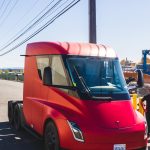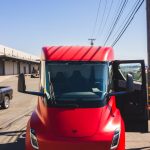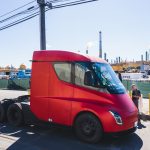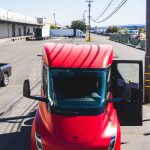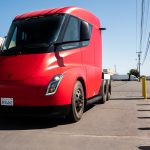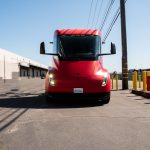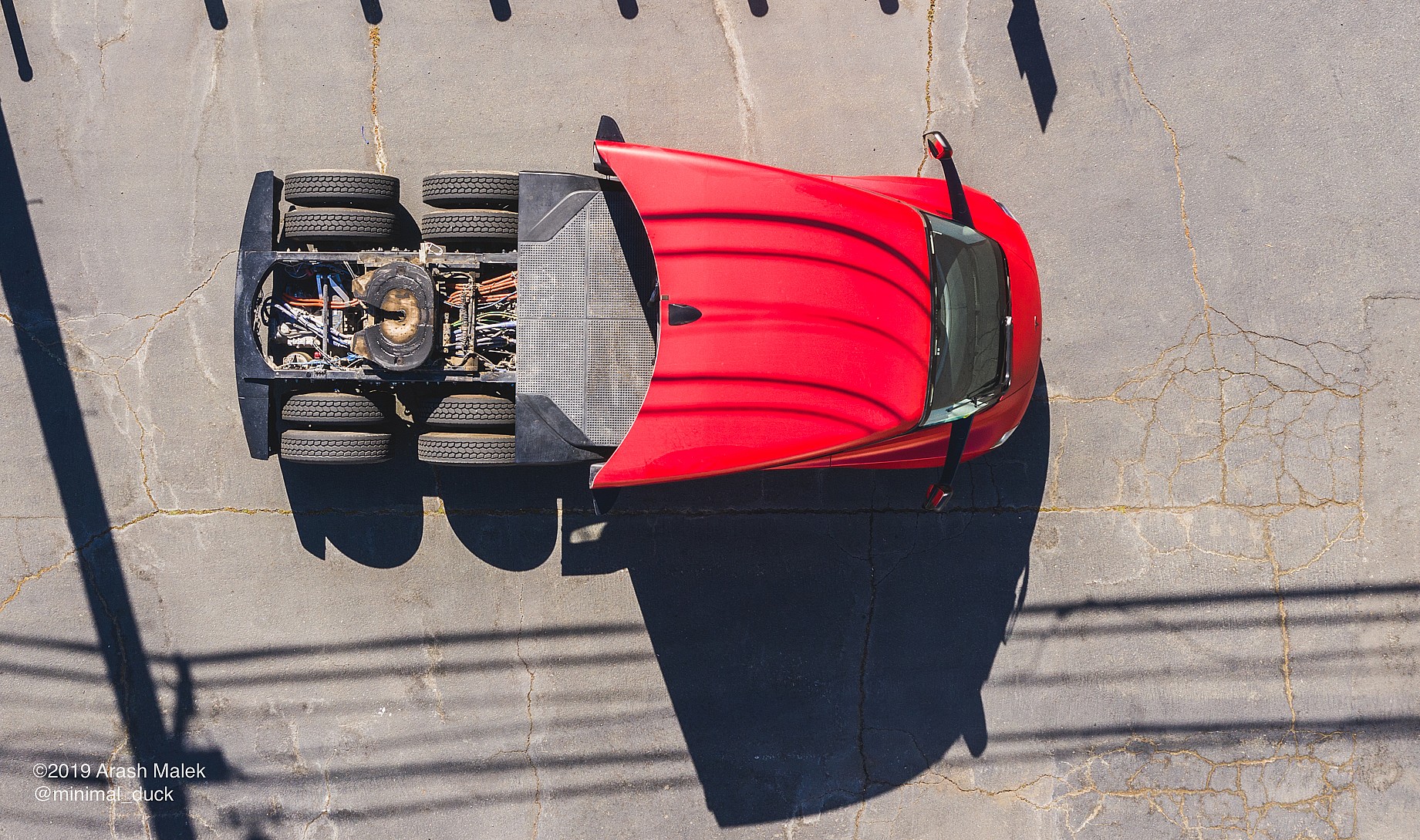
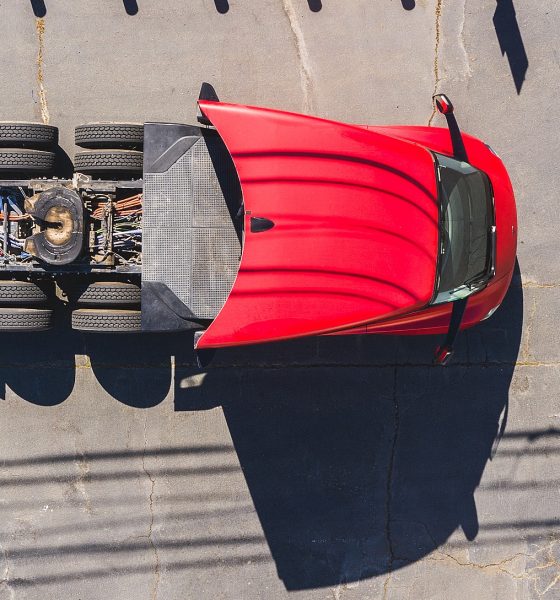
News
Tesla Semi to kick off Yandell Truckaway’s transition to an all-electric fleet
Following its visit to Pixar HQ for the esteemed animation studio’s green day celebration for employees, the Tesla Semi headed to the headquarters of another reservation holder: veteran transportation, logistics, and warehousing company Yandell Truckaway, which as been in the trucking business since 1945. Yandell had ordered 10 units of the Semi’s 300-mile version for its fleet, as part of its efforts to fully embrace sustainable solutions.
Yandell aims to utilize its Tesla all-electric trucks for its asset-based trucking division, with the vehicles operating in Northern California and catering to the area’s temperature controlled wine transportation and storage industry. This makes the Semi’s 300-mile variant perfect for Yandell’s business, as the trucks would likely have enough range to perform their day-to-day tasks and simply charge at night. In a statement, Yandell Truckaway COO John Yandell III remarked that the Semi is a perfect match for the company’s history of embracing bleeding edge technologies.
- The Tesla Semi visits Yandell Truckaway. (Photo: Arash Malek)
- The Tesla Semi visits Yandell Truckaway. (Photo: Arash Malek)
- The Tesla Semi visits Yandell Truckaway. (Photo: Arash Malek)
- The Tesla Semi visits Yandell Truckaway. (Photo: Arash Malek)
- The Tesla Semi visits Yandell Truckaway. (Photo: Arash Malek)
The Tesla Semi visits Yandell Truckaway. (Photo: Arash Malek)
“For over 70 years Yandell Truckaway has been serving the Northern California wine industry. Throughout that time we have prided ourselves by staying at the forefront of technology, making our operations more efficient and environmentally friendly. With the introduction of the Tesla Semi truck, we are looking forward to ushering in the most substantial and groundbreaking piece of technology the trucking industry has ever seen,” the COO said.
The executive made it clear that the 10 Tesla Semis Yandell Truckaway ordered are intended to replace the trucks that the company is currently using. Eventually, Yandell plans to transition its fleet into zero-emissions trucks. With this in mind, the trucking veteran is laying the groundwork to prepare for the deployment of its Tesla Semi fleet, as well as its succeeding sustainable initiatives. A huge part of this will be the company’s charging infrastructure, which will likely be a key factor in determining whether or not its EV trucking push will succeed.
- The Tesla Semi visits Yandell Truckaway. (Photo: Arash Malek)
- The Tesla Semi visits Yandell Truckaway. (Photo: Arash Malek)
- The Tesla Semi visits Yandell Truckaway. (Photo: Arash Malek)
- The Tesla Semi visits Yandell Truckaway. (Photo: Arash Malek)
- The Tesla Semi visits Yandell Truckaway. (Photo: Arash Malek)
- The Tesla Semi visits Yandell Truckaway. (Photo: Arash Malek)
The Tesla Semi visits Yandell Truckaway. (Photo: Arash Malek)
To address the charging needs of its upcoming electric truck fleet, the COO stated that Yandell is looking to set up a new building that will include solar panels that will help provide the power that will charge its Tesla Semis. Other electric trucks that the company plans to use, as well as electric-powered forklifts for its warehousing operations, will be charged using this upcoming building as well.
The Tesla Semi holds the potential to disrupt the lucrative trucking market. To allow the vehicle to be competitive, Tesla designed its truck to capitalize on the strengths of EVs as much as possible. The Semi is equipped with four Model 3-derived electric motors, which allow the long-hauler to accelerate from 0-60 mph in 5 seconds flat while bobtailing. With a full load, the Semi is capable of hitting highway speed in around 20 seconds, far quicker than diesel-powered trucks. The Semi will also feature a unique “Convoy Mode,” which would allow multiple trucks to semi-autonomously draft close to each other.
The Tesla Semi was initially announced for production in 2019, though this date has been adjusted for 2020. The company has hinted at improvements in the Semi since its unveiling, with Elon Musk teasing that the production long-range variant of the truck will have closer to 600 miles of range per charge.
Watch some sleek drone footage of the Tesla Semi in its visit to Yandell Truckaway in the video below.
https://youtu.be/JLtJ7SeZehQ

Elon Musk
Elon Musk and Tesla AI Director share insights after empty driver seat Robotaxi rides
The executives’ unoccupied tests hint at the rapid progress of Tesla’s unsupervised Robotaxi efforts.

Tesla CEO Elon Musk and AI Director Ashok Elluswamy celebrated Christmas Eve by sharing personal experiences with Robotaxi vehicles that had no safety monitor or occupant in the driver’s seat. Musk described the system’s “perfect driving” around Austin, while Elluswamy posted video from the back seat, calling it “an amazing experience.”
The executives’ unoccupied tests hint at the rapid progress of Tesla’s unsupervised Robotaxi efforts.
Elon and Ashok’s firsthand Robotaxi insights
Prior to Musk and the Tesla AI Director’s posts, sightings of unmanned Teslas navigating public roads were widely shared on social media. One such vehicle was spotted in Austin, Texas, which Elon Musk acknowleged by stating that “Testing is underway with no occupants in the car.”
Based on his Christmas Eve post, Musk seemed to have tested an unmanned Tesla himself. “A Tesla with no safety monitor in the car and me sitting in the passenger seat took me all around Austin on Sunday with perfect driving,” Musk wrote in his post.
Elluswamy responded with a 2-minute video showing himself in the rear of an unmanned Tesla. The video featured the vehicle’s empty front seats, as well as its smooth handling through real-world traffic. He captioned his video with the words, “It’s an amazing experience!”
Towards Unsupervised operations
During an xAI Hackathon earlier this month, Elon Musk mentioned that Tesla owed be removing Safety Monitors from its Robotaxis in Austin in just three weeks. “Unsupervised is pretty much solved at this point. So there will be Tesla Robotaxis operating in Austin with no one in them. Not even anyone in the passenger seat in about three weeks,” he said. Musk echoed similar estimates at the 2025 Annual Shareholder Meeting and the Q3 2025 earnings call.
Considering the insights that were posted Musk and Elluswamy, it does appear that Tesla is working hard towards operating its Robotaxis with no safety monitors. This is quite impressive considering that the service was launched just earlier this year.
Elon Musk
Starlink passes 9 million active customers just weeks after hitting 8 million
The milestone highlights the accelerating growth of Starlink, which has now been adding over 20,000 new users per day.

SpaceX’s Starlink satellite internet service has continued its rapid global expansion, surpassing 9 million active customers just weeks after crossing the 8 million mark.
The milestone highlights the accelerating growth of Starlink, which has now been adding over 20,000 new users per day.
9 million customers
In a post on X, SpaceX stated that Starlink now serves over 9 million active users across 155 countries, territories, and markets. The company reached 8 million customers in early November, meaning it added roughly 1 million subscribers in under seven weeks, or about 21,275 new users on average per day.
“Starlink is connecting more than 9M active customers with high-speed internet across 155 countries, territories, and many other markets,” Starlink wrote in a post on its official X account. SpaceX President Gwynne Shotwell also celebrated the milestone on X. “A huge thank you to all of our customers and congrats to the Starlink team for such an incredible product,” she wrote.
That growth rate reflects both rising demand for broadband in underserved regions and Starlink’s expanding satellite constellation, which now includes more than 9,000 low-Earth-orbit satellites designed to deliver high-speed, low-latency internet worldwide.
Starlink’s momentum
Starlink’s momentum has been building up. SpaceX reported 4.6 million Starlink customers in December 2024, followed by 7 million by August 2025, and 8 million customers in November. Independent data also suggests Starlink usage is rising sharply, with Cloudflare reporting that global web traffic from Starlink users more than doubled in 2025, as noted in an Insider report.
Starlink’s momentum is increasingly tied to SpaceX’s broader financial outlook. Elon Musk has said the satellite network is “by far” the company’s largest revenue driver, and reports suggest SpaceX may be positioning itself for an initial public offering as soon as next year, with valuations estimated as high as $1.5 trillion. Musk has also suggested in the past that Starlink could have its own IPO in the future.
News
NVIDIA Director of Robotics: Tesla FSD v14 is the first AI to pass the “Physical Turing Test”
After testing FSD v14, Fan stated that his experience with FSD felt magical at first, but it soon started to feel like a routine.

NVIDIA Director of Robotics Jim Fan has praised Tesla’s Full Self-Driving (Supervised) v14 as the first AI to pass what he described as a “Physical Turing Test.”
After testing FSD v14, Fan stated that his experience with FSD felt magical at first, but it soon started to feel like a routine. And just like smartphones today, removing it now would “actively hurt.”
Jim Fan’s hands-on FSD v14 impressions
Fan, a leading researcher in embodied AI who is currently solving Physical AI at NVIDIA and spearheading the company’s Project GR00T initiative, noted that he actually was late to the Tesla game. He was, however, one of the first to try out FSD v14.
“I was very late to own a Tesla but among the earliest to try out FSD v14. It’s perhaps the first time I experience an AI that passes the Physical Turing Test: after a long day at work, you press a button, lay back, and couldn’t tell if a neural net or a human drove you home,” Fan wrote in a post on X.
Fan added: “Despite knowing exactly how robot learning works, I still find it magical watching the steering wheel turn by itself. First it feels surreal, next it becomes routine. Then, like the smartphone, taking it away actively hurts. This is how humanity gets rewired and glued to god-like technologies.”
The Physical Turing Test
The original Turing Test was conceived by Alan Turing in 1950, and it was aimed at determining if a machine could exhibit behavior that is equivalent to or indistinguishable from a human. By focusing on text-based conversations, the original Turing Test set a high bar for natural language processing and machine learning.
This test has been passed by today’s large language models. However, the capability to converse in a humanlike manner is a completely different challenge from performing real-world problem-solving or physical interactions. Thus, Fan introduced the Physical Turing Test, which challenges AI systems to demonstrate intelligence through physical actions.
Based on Fan’s comments, Tesla has demonstrated these intelligent physical actions with FSD v14. Elon Musk agreed with the NVIDIA executive, stating in a post on X that with FSD v14, “you can sense the sentience maturing.” Musk also praised Tesla AI, calling it the best “real-world AI” today.

